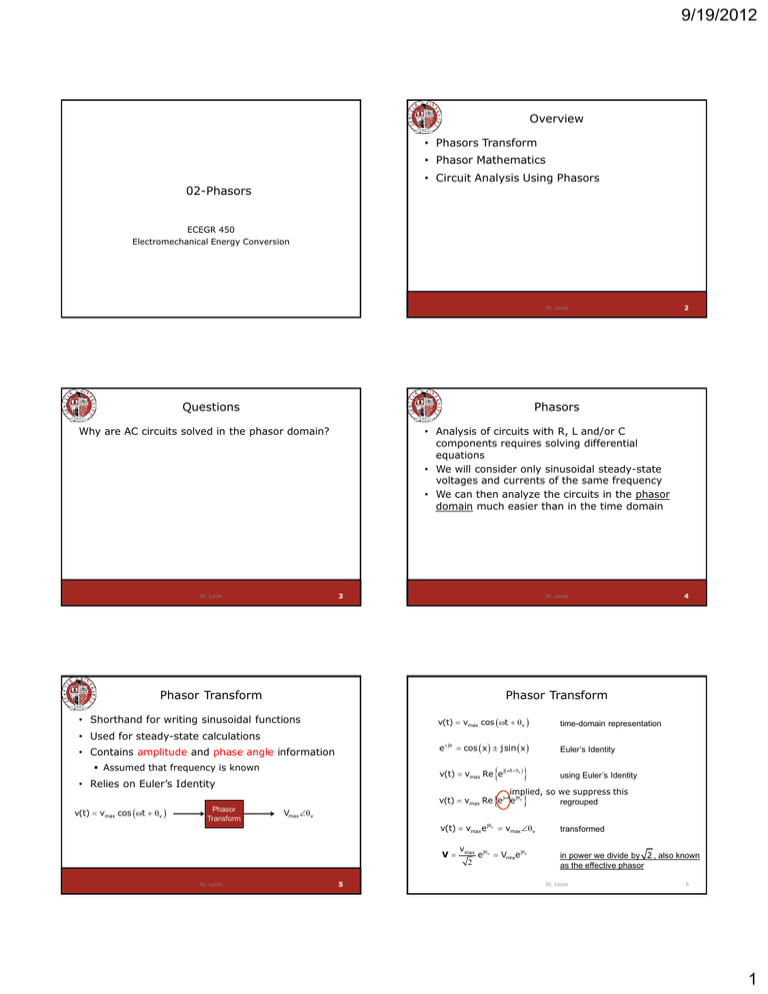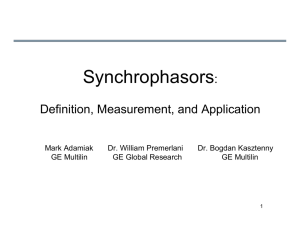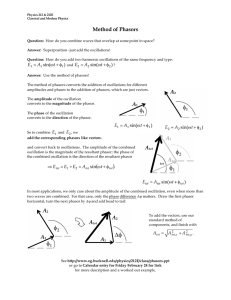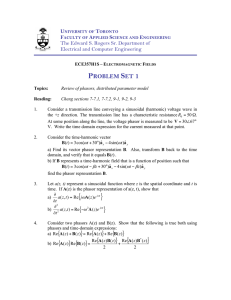02-Phasors - Dr. Henry Louie
advertisement

9/19/2012
Overview
• Phasors Transform
• Phasor Mathematics
• Circuit Analysis Using Phasors
02-Phasors
ECEGR 450
Electromechanical Energy Conversion
Dr. Louie
Questions
Phasors
Why are AC circuits solved in the phasor domain?
• Analysis of circuits with R, L and/or C
components requires solving differential
equations
• We will consider only sinusoidal steady-state
voltages and currents of the same frequency
• We can then analyze the circuits in the phasor
domain much easier than in the time domain
3
Dr. Louie
Dr. Louie
Phasor Transform
• Used for steady-state calculations
• Contains amplitude and phase angle information
Assumed that frequency is known
v(t) vmax cos t v
time-domain representation
e jx cos x j sin x
Euler’s Identity
v(t) vmax Re e
• Relies on Euler’s Identity
Phasor
Transform
j t v
using Euler’s Identity
implied, so we suppress this
v(t) vmax Re e jt e jv
regrouped
Vmax v
v(t) vmax ejv vmax v
V
vmax
2
Dr. Louie
4
Phasor Transform
• Shorthand for writing sinusoidal functions
v(t) vmax cos t v
2
5
e jv Vrmse jv
transformed
in power we divide by 2 , also known
as the effective phasor
Dr. Louie
6
1
9/19/2012
Phasor Transform
Notation
• We use the effective phasor because
• A bug in the notation
• Book uses a tilde to indicate that a variable is a
phasor, as in V, I
P vrmsirms cos()
So we can then write
P VI cos()
• Unless otherwise specified, assume that voltages
and currents are given in RMS and all phasors are
“effective phasors”
• Also note:
In other words, V, I are understood to have a
magnitude and phase component
• Book uses V, I to indicate the magnitude of the
phasor
e j90 cos(90o ) jsin(90o ) jsin(90o ) j
7
Dr. Louie
8
Dr. Louie
Notation
Phasors
• Lecture slides use bold uppercase variables (e.g.
V, I) for phasors and other vectors
• Capital letters (e.g. V, I) or absolute values of
phasors (|V|, |I|) are used to indicate the
magnitude of the phasor
• write the phasor
representation of
v1(t) 1.41 cos 377t 0
V V
• Lowercase variables (e.g. v, i) are preferred to
represent scalars not associated with phasors and
vectors
Notable exceptions P, Q for real and imaginary
power
• write the phasor
representation of
v2 (t) 2.12 cos 377t 45
• write the phasor
representation of
v3 (t) 1.41 cos t 0
9
Dr. Louie
10
Dr. Louie
Phasors
Phasors
Phasors have a direct geometric interpretation
• write the phasor
representation of
solution
• write the phasor
representation of
solution
v1(t) 1.41 cos 377t 0
Polar form
V1 10
v2 (t) 2.12 cos 377t 45
V1 145
V1 45o
V2 1.545
• write the phasor
representation of
V2 30
Horizontal is reference
solution
v3 (t) 1.41 cos t 0
V3 10
Dr. Louie
11
Dr. Louie
12
2
9/19/2012
Phasors
Addition of Phasors
• Another way of specifying phasors is in
rectangular form
• Addition and subtraction of phasors are simple
using rectangular form
Let the Y-axis be the imaginary (j) axis
Let the X-axis be the real axis
Simply add/subtract the real values and
add/subtract the imaginary values
V3 V1 V2 3.707 j0.707
• Resolving into real and imaginary components
V1 145 0.707 j0.707
Addition is “tip to tail”
Subtraction is “tail to tip”
V2 30 3 j0
imag
imag
V1 145
V1
V3
real
V2 30
real
13
Dr. Louie
14
Dr. Louie
Phasors
Phasors
• To convert from rectangular to polar:
• What is V3 in Phasor form?
V3 3.707 j.707
V = a + jb
V V
V2
b
a b tan
a
2
1
2
imag
V1
V2
V3
real
15
Dr. Louie
16
Dr. Louie
Phasors
Phasors
• What is V3 in Phasor form?
• What is V3 in the time domain?
V3 3.707 j.707
V V
imag
0.707
3.707 2 0.707 2 tan1
3.7710.8
3.707
V1
imag
V2
V3
V1
V2
V3
real
Dr. Louie
real
17
Dr. Louie
18
3
9/19/2012
Phasors
Multiplication of Phasors
• What is V3 in the time domain?
• Multiplication and division are easier in polar form
For multiplication: multiply magnitudes, add angles
For division: divide magnitudes, subtract angles
v(t) 3.77 2 cos(t 10.8 )
V4 V1V2 (145 )(30 )
V4 345
add angles
V4
multiply magnitudes
imag
V1
V2
imag
V3
real
Dr. Louie
real
19
20
Dr. Louie
Multiplication of Phasors
Phasor Analysis of Inductors
Using Matlab
• For inductors
>> V1=1*exp(j*45*pi/180)
V1 =
0.7071 + 0.7071i
>> V2=3*exp(j*0*pi/180)
V2 =
3
>> V3=V1+V2
V3 =
3.7071 + 0.7071i
>> Vmag=abs(V3)
Vmag =
3.7739
>> Vanglerad=angle(V3)
Vanglerad =
0.1885
>> Vangledeg=Vanglerad*180/pi
Vangledeg =
10.7991
i(t) imax cos(t i )
di
dt
v(t) Limax sin(t i ) Limax cos(t i 90o )
v(t) L
• Transforming into phasor form:
v(t) Limax cos(t i 90o )
o
V LIe ji e j90
V jLIe ji jLI
j 90
j
using e
Dr. Louie
21
Phasor Analysis
i(t)
v(t)
L
Dr. Louie
22
Phasor Analysis
V jLI
• We can rewrite Ohm’s Law to include complex
impedances
• V = IZ
• Define XL = L (inductive reactance)
• Therefore
Z: complex impedance (Ohms)
V = jXLI
• Z = R + jXL + jXC (if in series)
• 1/Z = 1/R + j/XL + j/XC (if in parallel)
• A similar derivation for capacitors yields
XC = -1/(C) (capacitive reactance)
V = jXCI
Dr. Louie
• Z will have a magnitude and phase associated
with it Z Zz
23
Dr. Louie
24
4
9/19/2012
Phasor Analysis
Phasor Analysis
• Z can be found by adding the R, XL and XC if in
series
• Parallel:
1/Z = 1/R + 1/(-jXC) + 1/(jXL)
Z = R + jXC + jXL
• Example
• Example
Z = 10 + -j2 + j3
Z = 10 + j (rectangular coordinates)
R=10
1/Z = 1/10 + 1/(j3) = 0.1 -0.333j
Z = 2.87 73.3o
jXC =-j2
Note:
Re{Z} = R
Im{Z} = Xc + XL
jXL =j3
R=10
25
Dr. Louie
26
Dr. Louie
Phasor Analysis
Phasor Analysis
• Note:
• Find the current out of the source, the power out
of the source, and power consumed by the
resistor assuming:
|V| = Vrms (magnitude of the phasor)
|I| = Irms
Vs = 120 Volts at 60 Hz
L = 0.01 Henry
R = 10 Ohms
• Using phasors
V = IZ
P = |V||I|cos()
P = |I|2R =|V|2/R
I
L
R
Vs
27
Dr. Louie
jXL =j3
28
Dr. Louie
Phasor Analysis
Phasor Analysis
• Vs = 120 Volts (RMS) at 60 Hz
• L = 0.01 Henry
Z (3.77 j 10)
jXL = jL = j(60 x 2p)x.01 = j3.77
3.77
3.77 2 102 tan1
10
Z 10.6920.7
• R = 10 Ohms
Vs IZ
I
1200
11.22 20.7 A
10.6920.7
phasor diagram
I
L
Vs
I
R
Vs
Dr. Louie
29
Dr. Louie
30
5
9/19/2012
Phasor Analysis
Summary
• Power from the source
• Phasor Domain: allows steady state AC circuits to be easily
analyzed (also graphical interpretation)
P | Vs || I | cos() (120)(11.22) cos(20.7 ) 1.26kW
• Power consumed by the load resistor
• Phasors: magnitude and phase info; freq. is assumed
v
V max e jv Vrmse jv
2
• Effective phasors are used in power systems
P | I |2 R 11.222 10 1.26kW
• The inductor does not consume any power P
I
Vs IZ
L
• Ohm’s Law in phasor domain:
R
Vs
Dr. Louie
31
Dr. Louie
32
6

![If F = (2.5+ j3.2) find P P [F]= 4.06cos(ω t + 52°) 2.5+ j3.2 = 2.5 + 3.2](http://s2.studylib.net/store/data/018459509_1-fbb455a35b72964a26b5dd36b7185505-300x300.png)


